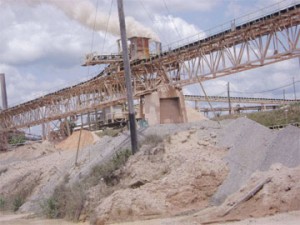Problem has worsened because of higher production
The health and environmental implications of bauxite production for Linden and its environs ought to be factored into the operations of the companies involved, according to Chairman of the Interim Management Committee of the Linden Mayor and Town Council (LMTC), Orrin Gordon.
In an extensive telephone interview with Stabroek Business earlier this week following last weekend’s protest in Linden over increased dust emission from the bauxite plant Gordon called for the setting up of “appropriate laboratory and medical facilities” in Linden which he said should be used “to pursue investigations into the impact of dust emission on the community and to make medical interventions where necessary.”

Community protests over increased levels of dust emission at Linden have surfaced even as the Government of Guyana appears upbeat about the prospects of a multi-million dollar investment in an Alumina smelter by the Chinese company Bosai.
Following last weekend’s protests which snarled traffic and brought normal activity to a halt, Gordon told Stabroek Business that what the people of Linden are seeking are assurances that the various other stakeholders in the society are prepared to stand with them in their quest to ensure that Bosai keeps its promise to implement measures to significantly reduce the dust levels within a specific time frame.
Gordon told Stabroek Business that while the community was aware the Chinese technicians had already visited Linden in connection with the promised “dust shield” the question that arises is “the time frame” for putting the dust–reduction measures in place. Gordon explained that with the advent of Bosai the problem of dust emission had grown worse since the company was now producing more bauxite than its predecessor, Omai Bauxite Ltd. He added that whereas, in the past, the dust emission problem was affecting smaller sections of the community, the entire community is now affected. “Anxiety levels are clearly rising and the community is seeking assurances that their concerns are being taken seriously,” Gordon said.
The IMC Chairman explained that the increased level of dust emission from the stacks above the bauxite plant had been compounded by the fact that Bosai was no longer using the traditional railway system for hauling bauxite but was now moving the product by trucks along dusty roads.
Gordon said that as far as he was aware the dust reduction system being put in place by Bosai is designed to recycle the bauxite dust to enable a 60 per cent reduction in emissions. Gordon said that he felt that the assurances offered by Bosai ought to be accompanied by “supporting gestures” from government and the Environ-mental Protection Agency (EPA) aimed at reassuring residents that the problem is being treated seriously.
Several weeks ago a Bosai official told this newspaper that the company proposed to make once-monthly medical interventions in an effort to provide treatment to persons affected by the dust emission. However, Gordon questioned the periodicity of the Bosai medical intervention pointing out that it had not been in evidence “for some time now.” Gordon told Stabroek Business that in the circumstances the effectiveness of the medical intervention was questionable since, while, the entire Linden community was now affected by the dust emission from the bauxite plant, “such treatment as is available only affects a few hundred people in a particular area.”
Gordon said that at this stage he was concerned that far too little was still known about the impact of the dust emission including its implications for the safety of drinking water in the community.




